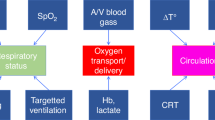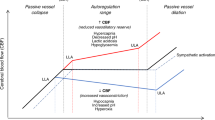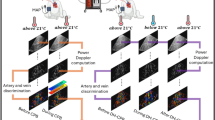Abstract
Impaired cerebral autoregulation (CA) is common and is associated with brain damage in sick neonates. Frequency analysis using spontaneous changes in arterial blood pressure (ABP) and cerebral near-infrared spectroscopy (NIRS) has been used to measure CA in several clinical studies. Coherence of the NIRS and ABP signals (i.e. correlation in the frequency domain) detects impairment of CA, whereas gain (i.e. magnitude of ABP variability passing from systemic to cerebral circulation) estimates the degree of this impairment. So far, however, this method has not been validated. In 12 newborn piglets, we compared NIRS-derived measures of CA with a conventional measure of CA: cerebral blood flow was measured by laser Doppler flowmetry, and changes in ABP were induced by inflating a thoracic aorta balloon. CA capacity was calculated as %ΔCVR/%ΔABP (i.e. percentage of full autoregulatory capacity), where CVR (i.e. cerebral vascular resistance) was estimated as ABP/Doppler flux. Correlation between coherence and CA capacity (r = −0.34, n = 24, p > 0.05) and between gain and CA capacity (r = −0.11, n = 24, p > 0.05) was limited. As expected, however, gain was significantly associated with CA capacity in measurements with significant coherence (r = −0.55, n = 15, p = 0.03). In conclusion, our data validate frequency analysis for estimation of CA in clinical research. Low precision, however, hampers its clinical application.
Similar content being viewed by others

Log in or create a free account to read this content
Gain free access to this article, as well as selected content from this journal and more on nature.com
or
Abbreviations
- ABP:
-
arterial blood pressure
- CA:
-
cerebral autoregulation
- CBF:
-
cerebral blood flow
- CVR:
-
cerebrovascular resistance
- CVRe:
-
estimated cerebrovascular resistance
- IVH:
-
intraventricular hemorrhage
- LDF:
-
laser Doppler flowmetry
- LF:
-
low frequency (0.003–0.04 Hz)
- MAP:
-
mean arterial blood pressure
- NIRS:
-
near-infrared spectroscopy
- OI:
-
oxygenation index
- PSD:
-
power spectral density
- VLF:
-
very low frequency (0.04–0.1 Hz)
References
Greisen G 2007 Autoregulation of cerebral blood flow. NeoReviews 8: e22–e31
Boylan GB, Young K, Panerai RB, Rennie JM, Evans DH 2000 Dynamic cerebral autoregulation in sick newborn infants. Pediatr Res 48: 12–17
Tyszczuk L, Meek J, Elwell C, Wyatt JS 1998 Cerebral blood flow is independent of mean arterial blood pressure in preterm infants undergoing intensive care. Pediatrics 102: 337–341
Pryds O, Greisen G, Lou H, Friis-Hansen B 1989 Heterogeneity of cerebral vasoreactivity in preterm infants supported by mechanical ventilation. J Pediatr 115: 638–645
Lou HC, Lassen NA, Friis-Hansen B 1979 Impaired autoregulation of cerebral blood flow in the distressed newborn infant. J Pediatr 94: 118–121
Baumbach GL, Heistad DD 1985 Regional, segmental, and temporal heterogeneity of cerebral vascular autoregulation. Ann Biomed Eng 13: 303–310
Giller CA 1990 The frequency-dependent behavior of cerebral autoregulation. Neurosurgery 27: 362–368
Elwell CE, Cope M, Delpy DT 1997 An analytical method for determining cerebrovascular transit time using near infrared spectroscopy. Adv Exp Med Biol 428: 561–568
Soul JS, Hammer PE, Tsuji M, Saul JP, Bassan H, Limperopoulos C, Disalvo DN, Moore M, Akins P, Ringer S, Volpe JJ, Trachtenberg F, du Plessis AJ 2007 Fluctuating pressure-passivity is common in the cerebral circulation of sick premature infants. Pediatr Res 61: 467–473
O'Leary H, Gregas MC, Limperopoulos C, Zaretskaya I, Bassan H, Soul JS, Di Salvo DN, du Plessis AJ 2009 Elevated cerebral pressure passivity is associated with prematurity-related intracranial hemorrhage. Pediatrics 124: 302–309
Tsuji M, Saul JP, du Plessis A, Eichenwald E, Sobh J, Crocker R, Volpe JJ 2000 Cerebral intravascular oxygenation correlates with mean arterial pressure in critically ill premature infants. Pediatrics 106: 625–632
Wong FY, Leung TS, Austin T, Wilkinson M, Meek JH, Wyatt JS, Walker AM 2008 Impaired autoregulation in preterm infants identified by using spatially resolved spectroscopy. Pediatrics 121: e604–e611
Brady KM, Lee JK, Kibler KK, Smielewski P, Czosnyka M, Easley RB, Koehler RC, Shaffner DH 2007 Continuous time-domain analysis of cerebrovascular autoregulation using near-infrared spectroscopy. Stroke 38: 2818–2825
Strebel S, Lam AM, Matta B, Mayberg TS, Aaslid R, Newell DW 1995 Dynamic and static cerebral autoregulation during isoflurane, desflurane, and propofol anesthesia. Anesthesiology 83: 66–76
Pryds A, Tonnesen J, Pryds O, Knudsen GM, Greisen G 2005 Cerebral pressure autoregulation and vasoreactivity in the newborn rat. Pediatr Res 57: 294–298
Soul JS, Taylor GA, Wypij D, Duplessis AJ, Volpe JJ 2000 Noninvasive detection of changes in cerebral blood flow by near-infrared spectroscopy in a piglet model of hydrocephalus. Pediatr Res 48: 445–449
Tsuji M, duPlessis A, Taylor G, Crocker R, Volpe JJ 1998 Near infrared spectroscopy detects cerebral ischemia during hypotension in piglets. Pediatr Res 44: 591–595
Hahn GH, Christensen KB, Leung TS, Greisen G 2010 Precision of coherence analysis to detect cerebral autoregulation by near-infrared spectroscopy in preterm infants. J Biomed Opt 15: 037002
Tiecks FP, Lam AM, Aaslid R, Newell DW 1995 Comparison of static and dynamic cerebral autoregulation measurements. Stroke 26: 1014–1019
Chapados I, Cheung PY 2008 Not all models are created equal: animal models to study hypoxic-ischemic encephalopathy of the newborn. Commentary on Gelfand SL et al.: a new model of oxidative stress in rat pups (Neonatology 2008;94:293–299). Neonatology 94: 300–303
Armstead WM 2000 Age-dependent cerebral hemodynamic effects of traumatic brain injury in newborn and juvenile pigs. Microcirculation 7: 225–235
Klaessens JH, Kolkman RG, Hopman JC, Hondebrink E, Liem KD, Steenbergen W, de Mul FF, Thijssen JM 2003 Monitoring cerebral perfusion using near-infrared spectroscopy and laser Doppler flowmetry. Physiol Meas 24: N35–N40
Peng T, Rowley AB, Ainslie PN, Poulin MJ, Payne SJ 2010 Wavelet phase synchronization analysis of cerebral blood flow autoregulation. IEEE Trans Biomed Eng 57: 960–968
Greisen G 2009 To autoregulate or not to autoregulate—that is no longer the question. Semin Pediatr Neurol 16: 207–215
Acknowledgements
We thank animal health technicians Letty Klarskov and Mette Værum Olesen for their practical help in the experiments. We also thank Senior Research Fellow Terence Leung, Ph.D., from Department of Medical Physics and Bioengineering, University College, London, for programming the software used to carry out the signal analysis.
Author information
Authors and Affiliations
Corresponding author
Additional information
Supported by the Ludvig and Sara Elsass Foundation and the University of Copenhagen, Denmark.
Rights and permissions
About this article
Cite this article
Hahn, G., Heiring, C., Pryds, O. et al. Applicability of Near-Infrared Spectroscopy to Measure Cerebral Autoregulation Noninvasively in Neonates: A Validation Study in Piglets. Pediatr Res 70, 166–170 (2011). https://doi.org/10.1203/PDR.0b013e3182231d9e
Received:
Accepted:
Issue date:
DOI: https://doi.org/10.1203/PDR.0b013e3182231d9e
This article is cited by
-
Near-infrared spectroscopy monitoring of neonatal cerebrovascular reactivity: where are we now?
Pediatric Research (2023)
-
Cerebral oxygen saturation and autoregulation during hypotension in extremely preterm infants
Pediatric Research (2021)
-
Monitoring cerebrovascular reactivity in pediatric traumatic brain injury: comparison of three methods
Child's Nervous System (2021)
-
Neonatal cerebrovascular autoregulation
Pediatric Research (2018)
-
Cerebral autoregulation and activity after propofol for endotracheal intubation in preterm neonates
Pediatric Research (2018)


